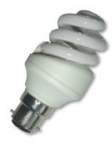The Lightbulb Debate
 The debate is not about whether it's "lightbulb" or "light bulb" or even how many
[insert chosen group here] it takes to change one,
but whether tungsten filament bulbs should
be outlawed by legislative means in favour compact fluorescent lamps (CFLs). From the wealth of debate
(BBC, Ban The Bulb) and comment,
it appears that everyone is in general agreement that withdrawing filament bulbs is a good idea - it's just that until only recently are their replacements at
a sufficiently developed stage. CFLs have largely replaced filament bulbs in conventional screw or bayonet sockets with manufacturers finally making CFLs that look like
traditional bulbs. Typical concerns have been:
The debate is not about whether it's "lightbulb" or "light bulb" or even how many
[insert chosen group here] it takes to change one,
but whether tungsten filament bulbs should
be outlawed by legislative means in favour compact fluorescent lamps (CFLs). From the wealth of debate
(BBC, Ban The Bulb) and comment,
it appears that everyone is in general agreement that withdrawing filament bulbs is a good idea - it's just that until only recently are their replacements at
a sufficiently developed stage. CFLs have largely replaced filament bulbs in conventional screw or bayonet sockets with manufacturers finally making CFLs that look like
traditional bulbs. Typical concerns have been:
- they're too large or the wrong shape to fit existing fittings
- they are completely out of place in period fittings, e.g. chandeliers, candelabra, carriage lanterns, etc.
- they produce a "cold" light that's not conducive to mood lighting
- the quoted lifetime is rarely achievable in normal domestic usage
- they cost too much (though some stores offer them in bulk at less £1 each)
- they start up dimly and can take several minutes to reach full brightness
- one filamant bulb ideally needs to be replaced by two CFLs to achieve similar lighting
CFLs do cost more to produce, mainly because they are complicated electronic devices. However, even if the cost of the componments falls, the energy to produce one is about 4kWh compared with 1kWh for a filament bulb.
Perhaps the better solution is to switch immediately to LED lighting and make CFLs obsolete. LEDs are expensive and the problem of uni-directional lighting is solved by using multiple LEDs in a cluster. They have the following advantages:
- they start at full brightness instantly
- they are even more efficient than CFLs
- they have an even longer life, 10,000+ hours
- they are smaller than CFLs and so could be made in shapes and sizes that eliminate interchangeability problems.
Part L of the UK Building Regulations introduced in April 2006 covers conservation of fuel and power and is clearly aiming to reduce energy consumption by providing guidance on heating, lighting, ventilation and insulation. For lighting, it specifies a minimum number of lumens to be output per circuit Watt and this effectively precludes the use of conventional tungsten filament lighting.






